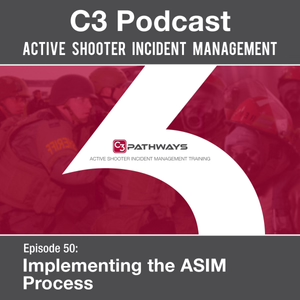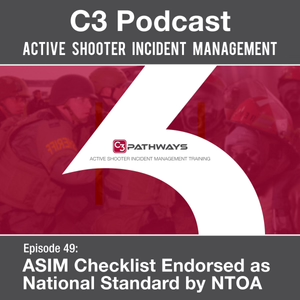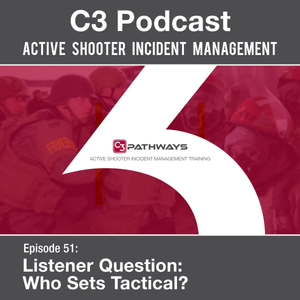
Ep 50: Implementing the ASIM Process
08/01/22 • 48 min
Ep 50: Implementing the ASIM Process
Sheriff Michelle Cook and Police Chief Terry Nichols share their experiences implementing the Active Shooter Incident Management Checklist process and their tips for success. Don't miss this discussion!
Bill Godfrey:
Welcome to the Active Shooter Incident Management Podcast. It's good to be back with you today. My name is Bill Godfrey. I'm your podcast host, and I have with me today two former C3 instructors as our guest stars today, both of them law enforcement leaders, and hoping that one day when they do retire-retire, we might actually get them back as C3 instructors; hint hint, Chief Nichols, who just retired in the last few weeks. So I have with me Michelle Cook. She is currently serving as the Sheriff in Clay County. She also did ... Michelle was almost 30 years at Jacksonville?
Michelle Cook:
26 years at Jacksonville, yeah.
Bill Godfrey:
Yeah, so 26 years at Jacksonville Sheriff's Office Police Department as the operations chief, so she had an awful lot of responsibility there. Did a short stint as the Police Chief at Atlantic Beach, which was kind of a retirement job, but too easy for you. You needed something with more, and so now she's the elected Sheriff at Clay County, which is in north Florida. And we have with us Terry Nichols. Terry was the Assistant Director at Alert from the founding to, what was it? 2018, 20-
Terry Nichols:
2016, 2016.
Bill Godfrey:
2016. Left Alert, became the Police Chief in Brownwood, Texas, and then you did, what, a little over three years there?
Terry Nichols:
Three years there, and then moved to Seguin as chief, and spent three years there, and now I'm retired
Bill Godfrey:
Like a week and a half ago, two weeks ago? It's been pretty recent.
Terry Nichols:
It's been a month, it's been a month.
Bill Godfrey:
So it's exciting to have both of you here. I really appreciate you taking the time. I know the sheriff especially, you have a very busy schedule. But I wanted to have a podcast where we talk about implementing the Active Shooter Incident Management checklist and the process that goes with it. Because it sounds simple on the surface, and when you've gone through training, it's fairly straightforward, but trying to roll that out to a whole organization is a little bit of a logistics machine.
And the two of you have each done this, not only in your organizations, but you've done it more than once. So sheriff, you did it at Jacksonville, then did it at Atlantic Beach, now at Clay County, and Terry, you did it at both Brownwood and Seguin. So what I wanted to just get from you guys is, what was it about this process that made you say, "This is the way I want to go," and what were your lessons learned? How did you approach it and go along the way? So sheriff, you want to start us off?
Michelle Cook:
Sure. First of all, thank you for having me today to talk about this. I'm very passionate about this. You've asked why ASIM, why choose this method of managing an active shooter event, and I will tell you, I'm entering into my 30th year of law enforcement, and I've worked some huge cases, some huge incidents, thousands of them, and for me, being a street cop for so long and then the leader of street cops, the ASIM process, the ASIM methodology, it just makes sense.
In our industry, and Terry, correct me if you see differently, we teach young officers, young supervisors, to handle everything themselves. And on 99% of the calls that we handle, that can be done, but on a mass critical incident, like an active shooter event, relying on one person to handle everything is just unrealistic, and that's how things get missed, and unfortunately, that's how people die, is you got one person trying to handle everything.
Terry Nichols:
Yeah. For me, everything the sheriff said makes perfect sense, and she is spot on. Having been involved with Alert and standing it up from the get go, driving it post-Columbine, and how we were training cops, and then fast-forward several years and get introduced to the ASIM model, and realizing we had been missing the boat early on. When we started first training our officers, we were missing the management piece of this. We were doing good at going in and realizing that we have a different duty. There's no longer sit and wait for SWAT, that we had a different mission on these active shooter events.
But there's a whole management piece of this, and like the sheriff alluded to, that we're real good at teaching cops to go handle a problem by themselves, and they do it 9 times out of 10, but these events are catastrophic. They are geographical in nature. It doesn't just hap...
Ep 50: Implementing the ASIM Process
Sheriff Michelle Cook and Police Chief Terry Nichols share their experiences implementing the Active Shooter Incident Management Checklist process and their tips for success. Don't miss this discussion!
Bill Godfrey:
Welcome to the Active Shooter Incident Management Podcast. It's good to be back with you today. My name is Bill Godfrey. I'm your podcast host, and I have with me today two former C3 instructors as our guest stars today, both of them law enforcement leaders, and hoping that one day when they do retire-retire, we might actually get them back as C3 instructors; hint hint, Chief Nichols, who just retired in the last few weeks. So I have with me Michelle Cook. She is currently serving as the Sheriff in Clay County. She also did ... Michelle was almost 30 years at Jacksonville?
Michelle Cook:
26 years at Jacksonville, yeah.
Bill Godfrey:
Yeah, so 26 years at Jacksonville Sheriff's Office Police Department as the operations chief, so she had an awful lot of responsibility there. Did a short stint as the Police Chief at Atlantic Beach, which was kind of a retirement job, but too easy for you. You needed something with more, and so now she's the elected Sheriff at Clay County, which is in north Florida. And we have with us Terry Nichols. Terry was the Assistant Director at Alert from the founding to, what was it? 2018, 20-
Terry Nichols:
2016, 2016.
Bill Godfrey:
2016. Left Alert, became the Police Chief in Brownwood, Texas, and then you did, what, a little over three years there?
Terry Nichols:
Three years there, and then moved to Seguin as chief, and spent three years there, and now I'm retired
Bill Godfrey:
Like a week and a half ago, two weeks ago? It's been pretty recent.
Terry Nichols:
It's been a month, it's been a month.
Bill Godfrey:
So it's exciting to have both of you here. I really appreciate you taking the time. I know the sheriff especially, you have a very busy schedule. But I wanted to have a podcast where we talk about implementing the Active Shooter Incident Management checklist and the process that goes with it. Because it sounds simple on the surface, and when you've gone through training, it's fairly straightforward, but trying to roll that out to a whole organization is a little bit of a logistics machine.
And the two of you have each done this, not only in your organizations, but you've done it more than once. So sheriff, you did it at Jacksonville, then did it at Atlantic Beach, now at Clay County, and Terry, you did it at both Brownwood and Seguin. So what I wanted to just get from you guys is, what was it about this process that made you say, "This is the way I want to go," and what were your lessons learned? How did you approach it and go along the way? So sheriff, you want to start us off?
Michelle Cook:
Sure. First of all, thank you for having me today to talk about this. I'm very passionate about this. You've asked why ASIM, why choose this method of managing an active shooter event, and I will tell you, I'm entering into my 30th year of law enforcement, and I've worked some huge cases, some huge incidents, thousands of them, and for me, being a street cop for so long and then the leader of street cops, the ASIM process, the ASIM methodology, it just makes sense.
In our industry, and Terry, correct me if you see differently, we teach young officers, young supervisors, to handle everything themselves. And on 99% of the calls that we handle, that can be done, but on a mass critical incident, like an active shooter event, relying on one person to handle everything is just unrealistic, and that's how things get missed, and unfortunately, that's how people die, is you got one person trying to handle everything.
Terry Nichols:
Yeah. For me, everything the sheriff said makes perfect sense, and she is spot on. Having been involved with Alert and standing it up from the get go, driving it post-Columbine, and how we were training cops, and then fast-forward several years and get introduced to the ASIM model, and realizing we had been missing the boat early on. When we started first training our officers, we were missing the management piece of this. We were doing good at going in and realizing that we have a different duty. There's no longer sit and wait for SWAT, that we had a different mission on these active shooter events.
But there's a whole management piece of this, and like the sheriff alluded to, that we're real good at teaching cops to go handle a problem by themselves, and they do it 9 times out of 10, but these events are catastrophic. They are geographical in nature. It doesn't just hap...
Previous Episode

Ep 49: ASIM Checklist Endorsed as National Standard by NTOA
Ep 49: ASIM Checklist Endorsed as National Standard by NTOA
SPECIAL EPISODE - We have exciting news on this week's podcast! Our guest is Thor Eells, Executive Director of the National Tactical Officers Association (NTOA). Today, Thor shares the news NTOA is endorsing the C3 Pathways Active Shooter Incident Management Checklist as the national standard of incident management of active shooter events. We discuss the importance of setting national standards for first responder training. Thor also tells us what NTOA is working on, including a neuroplasticity program to help first responders make decisions faster and more accurately while under stress.
Bill Godfrey:
Welcome to the Active Shooter Incident Management Podcast. My name is Bill Godfrey. I'm your podcast host. It has been a minute since the last podcast we've done. I'm excited to be back, but I'm even more excited that we're back with a very special guest today. I would like to introduce you to Thor Eells, the executive director of the National Tactical Officers Association, known to our law enforcement audience as the NTOA. Thor, welcome.
Thor Eells:
Thank you very much.
Bill Godfrey:
Hey, before we get going on this, because we probably have some audience members that aren't familiar with NTOA because we have more than just law enforcement. Can you tell us a little bit about the NTOA and its mission and where you guys are going?
Thor Eells:
Absolutely. I appreciate the opportunity to do so. The NTOA is a nonprofit organization we originally created in 1983 by a then-lieutenant with the LA County Sheriff's Department, who was hoping to establish an association for networking information sharing among tactical teams in the United States while they were in their relative infancy and ensuring that through this shared information and knowledge, that it would professionalize this pledging self-discipline within law enforcement.
Over these past decades, this association grown now to roughly 40,000 members with specialties that now include patrol, tactical EMS, crisis negotiations, and corrections. We even now also have membership from fire and EMS as a result of the whole development of rescue task forces and the need, with these new emerging threats, for all of these disciplines to be able to work and collaborate together in critical incidents for successful outcomes. We teach roughly 200 classes a year. We have taught all over the world, and we have membership from five continents. So it has grown exponentially since the founder, John Coleman, first created the association.
Bill Godfrey:
Wow. That's fascinating. I didn't realize that you guys had formed back in 1983. That is pretty amazing. I'm so excited to hear you talk about the fire/EMS membership and the pursuit of rescue task force. Obviously we're going to talk about that a little bit today, but we've got a big announcement to offer today. You want to go ahead and break the news to the audience?
Thor Eells:
Well, happy to. We are extremely excited to be able to enter into this collaborative agreement with C3 Pathways and the endorsement and the creation of a lot of information sharing between our two entities, but particularly as it pertains to the active assailant/active shooter checklist. I think that this is really a very important and potentially impactful partnership in helping those first responders that are tasked with a very, very difficult job in making good decisions in a time-compressed and stressful environment. So I think this is just the beginning of many good things to come between our two companies and associations.
Bill Godfrey:
I think it's wonderful. I'm so very excited to have you guys recognize the checklist and endorse it as a national standard. I'm just blown away and so humbled by that, along with the rest of the C3 team and the instructors that have been doing training for years. It's an interesting phenomenon. We've been using the checklist and training for over 10 years now and have some 3,000 different agencies from law enforcement, fire, EMS, emergency management across the country that are using it.
But this is the first time that we've actually had a national standard-setting bodies such as yourself. For those not on the law enforcement side, NTOA is essentially to law enforcement, what the NFPA, the National Fire Protection Association is to the fire department in being able to set the standards and set national standards. We are just so honored to have you guys recognize that and endorse it.
I think it's a really big deal. I've obviously been gone from active duty for a little bit now, but it always made me more comfortable as a responder when I knew that the process or the procedure that I was following was a national standard. I...
Next Episode

Ep 51: Listener Question - Who Sets Tactical?
Episode 51: Listener Question - Who Sets Tactical?
This week are live on the road with the ASIM team in New York City. Today we are answering a former ASIM student's question on "Who sets tactical with only three or four officers on duty?"
Bill Godfrey:
Bill Godfrey: Welcome to the Active Shooter Incident Management Podcast. My name is Bill Godfrey, your podcast host. I have with me today, three of the C3 instructors, Kevin Burd, our Director of Training. Kevin, thanks for being here today.
Kevin Burd:
Thanks for having me, Bill.
Bill Godfrey:
All right. And we got Jason Kelley. Jason, good to have you here.
Jason Kelley:
Thank you, sir.
Bill Godfrey:
Or, as we call him, Slide Deck. And we have Coby Briehn. Coby, welcome back.
Coby Briehn:
Thanks for having me.
Bill Godfrey:
All right, so today we got something a little bit different for our topic today. We actually have an audience question. The question comes from a former student of ours from an ASIM course, and he says, "I work for a university police department in a city of about a hundred thousand. Our active shooter instructors have a question about setting up tactical. If we only have three or four armed officers on duty, such as the weekends or second shifts or third shifts." And the question is, "if we only have three officers to respond, do we send in a two-officer contact team and keep the third for tactical to manage the city and county officers who respond into the campus? Or do we give up tactical to have our third officer make entry and search for the threat and let the city officer take the lead on running tactical operations?" He goes on to say, "There's been some discussion both ways. There's not a consensus." And he is asking if we could provide a recommendation and the reasoning why we would recommend that as our course of action.
So, a number of interesting things here. He's concerned about the shifts where they've only got three or four officers on duty. Okay, so that's first of all. So, obviously, they got backup coming from the city and the county. I'm guessing one of the questions you guys have is, what's our response time for the city and the county? Let's assume the city's going to be right there because the university's in the city, a couple minutes, they're there pretty quick. And for the county, let's say it's a little bit longer, a little over 10 minutes for that. Before we get rolling on thoughts, does anybody have any other questions that they want to ask about it?
Kevin Burd:
My first question would be, what is the standard policies and procedures that they would operate under? Is everybody who's responding under the same guidance? Is it a countywide response plan? Is it three individual plans? That would probably dictate some of our answers or thoughts on this.
Bill Godfrey:
I think those are both great questions. And actually, I asked him a couple of those questions and he did give me some additional information. He said that they all three have some common training, but they have different policies and procedures. The university police has adopted the ASIM process. The others haven't gone quite that far. They've had to negotiate some things, so instead of tactical taking up the position and doing staging, they have tactical go to the door and control everything at the door. The other thing that I think is important to mention, is they do not have compatible communication systems. The university police doesn't have the ability to go to the city channels and the city police do not have the ability to go to the university channels. All right? Any other questions before we start talking or who wants to lead off?
Jason Kelley:
Oh, I'll lead off. This is Jason. I'll lead off. I guess my first concern is, three agencies on three separate channels. If you're going to place a university officer outside the tactical as that third officer, and sending to his contact teams to stop the killing. To me, that probably makes sense. So, they have direct line of communication from tactical to the interior units, additional resources responding. My opinion is, you need to then send a city and county to tactical, to that university officer, so now we have communications for additional responding officers.
Bill Godfrey:
All right. That's a tough call, right? I mean, you've only got three or four gun-toters to begin with, we're going to minus one to keep them outside to try to coordinate the rest of this response. Coby, what do you think? Two going in real quick with hopefully a couple more coming in a few minutes?
Coby Briehn:
Right. All good considerations. Off the top of my ...
If you like this episode you’ll love
Episode Comments
Generate a badge
Get a badge for your website that links back to this episode
<a href="https://goodpods.com/podcasts/c3-podcast-active-shooter-incident-management-15623/ep-50-implementing-the-asim-process-22948668"> <img src="https://storage.googleapis.com/goodpods-images-bucket/badges/generic-badge-1.svg" alt="listen to ep 50: implementing the asim process on goodpods" style="width: 225px" /> </a>
Copy




